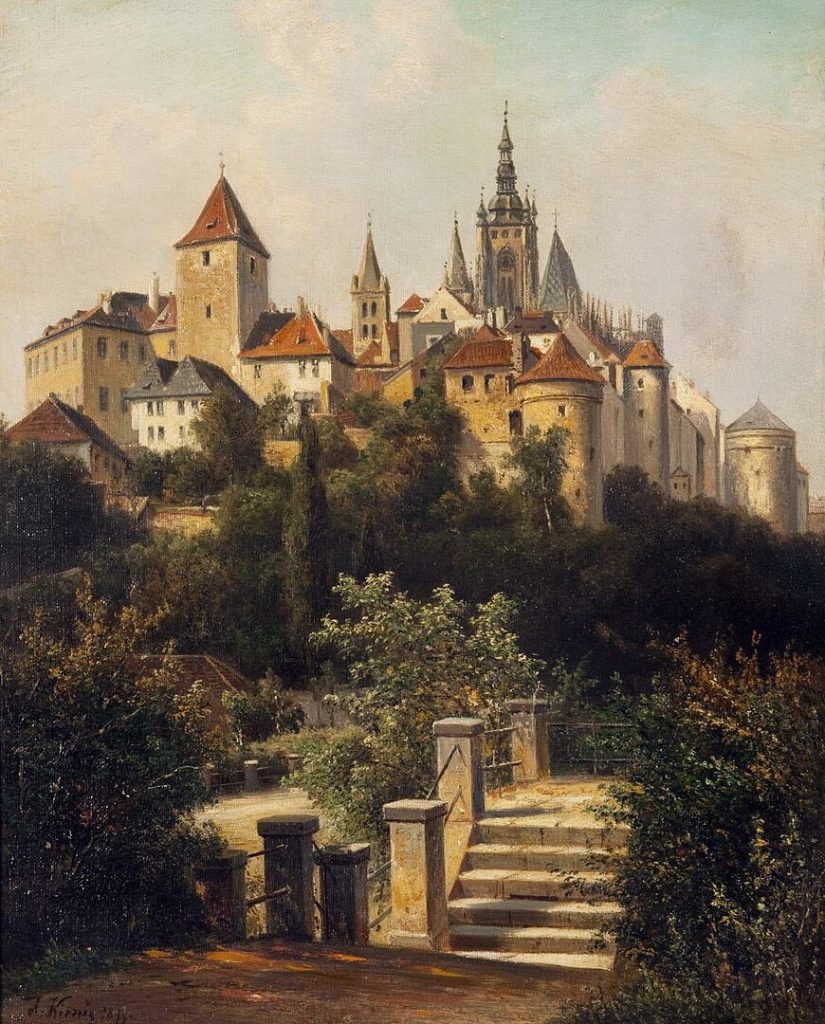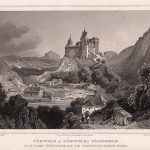
Prague Castle is one of the most breathtaking and historically significant landmarks in Europe. Standing proudly above the Vltava River, this sprawling architectural complex has been the seat of Czech rulers for over a thousand years. Its vast history is reflected in a stunning blend of architectural styles, from early Romanesque stonework to the soaring Gothic spires of St. Vitus Cathedral. Each era of Czech history has left its mark, making the castle a living testament to the country’s cultural and political evolution.
The castle is not a single structure but an extensive complex that includes churches, palaces, gardens, and fortifications. As the largest ancient castle in the world, covering nearly 70,000 square meters, it has been continuously expanded and renovated by various monarchs and ruling dynasties. From the medieval walls that once protected the early dukes of Bohemia to the refined Baroque palaces introduced by the Habsburgs, every architectural addition tells a story of ambition, power, and artistic influence.
One of the most remarkable aspects of Prague Castle’s architecture is its ability to harmonize different styles while maintaining a cohesive aesthetic. Gothic cathedrals, Renaissance courtyards, and Baroque halls all coexist within its walls, creating a visually stunning and historically rich environment. The castle’s strategic location on Hradčany Hill further enhances its grandeur, offering breathtaking views of Prague’s red rooftops and winding streets below.
Today, Prague Castle remains a cultural and political hub, serving as the official residence of the Czech president. Despite modern renovations and restorations, its architectural essence remains intact, drawing millions of visitors each year. Whether admired from afar or explored up close, the castle continues to captivate architects, historians, and travelers alike, preserving the legacy of the rulers and artists who shaped its monumental design.
The Origins: Romanesque Foundations
Prague Castle’s origins date back to the late 9th century, when Prince Bořivoj I of the Přemyslid dynasty established a fortified settlement on Hradčany Hill. This early version of the castle consisted mainly of wooden structures surrounded by a simple defensive wall. However, as the Přemyslids consolidated their power, they replaced these primitive buildings with stone constructions, marking the beginning of Romanesque architecture in Prague. This transformation set the foundation for the castle’s continuous expansion over the centuries.
One of the oldest surviving structures from this period is the Basilica of St. George, founded in the early 10th century. With its thick stone walls, small arched windows, and simple yet powerful design, it is a textbook example of Romanesque architecture. Unlike the highly ornamented styles that would follow, Romanesque buildings were defined by their sturdy and fortress-like appearance, emphasizing function over decoration. St. George’s Basilica remains one of the most well-preserved relics of early Prague, offering a glimpse into the medieval origins of the castle complex.
Beyond St. George’s Basilica, remnants of Romanesque architecture can still be seen in the castle’s underground foundations and certain surviving walls. These early structures prioritized strength and security, as Prague Castle was both a political center and a fortress against invaders. The Romanesque period saw the construction of round towers and heavy stone walls, elements that provided a sense of permanence and protection. Even as later styles emerged, these defensive features remained integral to the castle’s identity.
The Romanesque phase of Prague Castle reflects a time of consolidation and expansion for the Bohemian state. The transition from wooden fortifications to stone structures not only strengthened the castle physically but also symbolized the rising power of the Přemyslid rulers. Though later Gothic and Renaissance elements would overshadow these early designs, the Romanesque foundations remain a crucial part of Prague Castle’s architectural and historical identity.
The Gothic Transformation: St. Vitus Cathedral’s Influence
The Gothic era brought one of the most dramatic transformations to Prague Castle, primarily through the construction of St. Vitus Cathedral. Commissioned by Emperor Charles IV in the 14th century, the cathedral was designed to be the spiritual and architectural heart of the castle. The renowned German architect Peter Parler took over the project and introduced innovative Gothic elements that would become defining features of Prague’s skyline. His work blended bold engineering with intricate artistic details, making the cathedral one of the finest examples of Gothic architecture in Central Europe.
St. Vitus Cathedral is characterized by its soaring spires, pointed arches, and ribbed vaulting, which allow for greater height and spacious interiors. The cathedral’s massive stained-glass windows, including the famous rose window above the main entrance, flood the interior with ethereal light. These windows depict biblical stories and historical figures, adding both color and narrative depth to the space. The cathedral also features elaborate stone tracery, flying buttresses, and gargoyles that serve both decorative and structural purposes.
One of the most impressive aspects of the cathedral is its interior, particularly the Chapel of St. Wenceslas. This ornate chapel, dedicated to the patron saint of Bohemia, is adorned with semi-precious stones and golden frescoes, creating an atmosphere of sacred grandeur. The cathedral also houses the tombs of Czech kings and emperors, further cementing its importance as a royal and religious landmark. The sheer scale and complexity of St. Vitus Cathedral reflect the ambitions of Charles IV, who sought to elevate Prague to the status of an imperial city.
Though the construction of St. Vitus Cathedral spanned several centuries, its Gothic essence remained intact. Later additions maintained the cathedral’s medieval aesthetic while incorporating Renaissance and Baroque elements. Today, it stands as one of the most iconic symbols of Prague, drawing visitors from around the world to admire its intricate architecture and historical significance. Its towering presence continues to dominate the castle complex, embodying the power and artistic vision of the medieval Bohemian kingdom.
Renaissance Elegance: A Shift in Style
By the 16th century, Renaissance ideals had spread across Europe, bringing a new approach to architecture that emphasized symmetry, proportion, and classical beauty. Under the rule of Emperor Ferdinand I and later Rudolf II, Prague Castle underwent significant Renaissance-style renovations, transforming parts of the complex with elegant courtyards, arcades, and decorative facades. Italian architects were invited to Prague, introducing a distinct Mediterranean influence to the city’s medieval skyline.
One of the finest examples of Renaissance architecture within the castle is the Royal Summer Palace, also known as the Belvedere. Built for Queen Anne, this exquisite structure features a symmetrical layout, grand colonnades, and an elegant arcaded terrace. The design reflects the Renaissance admiration for balance and harmony, moving away from the soaring verticality of the Gothic period. The palace’s delicate sgraffito decorations and ornamental fountains further enhance its aesthetic appeal.
Another important Renaissance contribution to the castle was the addition of refined residential spaces, including the Vladislav Hall. Originally built in the late Gothic style, this grand hall was later adapted to include Renaissance elements, such as wide windows that allowed more natural light to enter. The hall’s sheer size and graceful vaulted ceiling made it suitable for royal ceremonies, banquets, and even jousting tournaments. It represented the shift from fortress-like medieval spaces to more refined and luxurious living quarters.
During this period, Prague became a major center of science, art, and culture, particularly under Emperor Rudolf II. The Renaissance influence extended beyond architecture to painting, sculpture, and astronomy, making the castle a hub of intellectual and artistic activity. Although later Baroque modifications would alter certain Renaissance features, this era marked a significant departure from medieval aesthetics, embracing a more humanistic and artistic vision for Prague Castle’s development.
Baroque Grandeur: A Royal Statement
The 17th and 18th centuries ushered in the Baroque era, bringing an entirely new level of drama and opulence to Prague Castle. Under the rule of the Habsburg dynasty, particularly Empress Maria Theresa, the castle underwent significant Baroque renovations that added grandeur and theatricality to its already rich architectural tapestry. Baroque architecture, known for its elaborate ornamentation, curved lines, and play of light and shadow, transformed many parts of the castle complex into regal and decorative spaces fit for imperial power.
One of the most striking examples of Baroque influence within Prague Castle is the Spanish Hall. Originally constructed during the late Renaissance period, it was later redesigned in the Baroque style to serve as a magnificent ceremonial hall for grand receptions, banquets, and celebrations. Its impressive chandeliers, frescoed ceilings, and gilded stucco decorations reflect the extravagant tastes of the Habsburg rulers. The hall remains one of the most visually stunning interiors in the castle, embodying the spirit of Baroque theatricality.
Baroque architecture also left its mark on the exterior of the castle, particularly in the form of ornamental sculptures, grand staircases, and elaborate facades. The Matthias Gate, built in the early 17th century, serves as a prime example of the transition from Renaissance to Baroque styles. This grand entrance, adorned with imperial symbols and sculptural reliefs, marks a ceremonial threshold into the castle complex. The intricate detailing of its design conveys a sense of movement and dynamism, typical of the Baroque aesthetic.
Beyond the main halls and entrances, Baroque influence can also be seen in the castle gardens and chapels. The Castle Chapel of the Holy Cross, with its intricate frescoes and gilded altarpieces, showcases the period’s fascination with ornate religious imagery. Meanwhile, the redesign of certain gardens introduced more theatrical landscaping, featuring sculpted terraces, fountains, and geometrically arranged flower beds. These elements reinforced the grandeur of Prague Castle, ensuring it remained an imperial residence worthy of European royalty.
Neoclassical Touches and the Castle’s Modernization
As the Baroque period waned, Neoclassical architecture emerged in the late 18th and early 19th centuries, favoring simplicity, symmetry, and an emphasis on Greco-Roman ideals. During the reign of Empress Maria Theresa and later under Emperor Francis I, Prague Castle underwent another phase of transformation. While previous styles focused on ornamentation and theatricality, Neoclassicism introduced a sense of restraint and refinement, replacing excessive decoration with clean lines and balanced proportions.
One of the most notable Neoclassical additions to Prague Castle is the New Royal Palace. Designed to house administrative offices and royal apartments, the palace features symmetrical facades, evenly spaced columns, and restrained decorative elements. The architectural shift reflected changing tastes, as European rulers sought to align themselves with the ideals of the Enlightenment, favoring rationality and order over Baroque exuberance. The palace’s interiors were also updated, with elegant yet understated frescoes replacing the dramatic, gold-laden motifs of previous centuries.
A key figure in the Neoclassical transformation of Prague Castle was architect Niccolò Pacassi, who worked on the redesign of the castle’s residential quarters. His work introduced classical design elements, such as evenly spaced windows, triangular pediments, and smooth plastered facades. This period also saw improvements in urban planning around the castle, with new boulevards and squares enhancing accessibility and creating a more structured layout for the surrounding city.
Despite these changes, the essence of Prague Castle’s earlier styles remained intact. The Neoclassical modifications did not erase the medieval, Gothic, or Baroque elements but rather blended them into a more cohesive and organized whole. Today, the New Royal Palace continues to serve as an important government building, hosting official ceremonies and diplomatic events while maintaining its historical charm.
The Castle’s Fortifications and Defensive Structures
Prague Castle was not only a seat of power but also a military stronghold, and its architecture reflects a long history of fortification and defense. From the early medieval period to the modern age, various rulers reinforced its walls, towers, and gates to protect against invaders. The strategic location on Hradčany Hill made it an ideal defensive position, allowing watchtowers to survey the surrounding landscape and control access to the city below.
One of the most well-known defensive structures within Prague Castle is Daliborka Tower. Built in the late 15th century as part of the castle’s fortifications, this cylindrical tower functioned as a prison for nobles and political enemies. Its thick stone walls and narrow windows are typical of late medieval military architecture, designed to withstand sieges and provide a secure holding area for prisoners. The tower’s dark and eerie interior, once filled with chains and torture devices, is a chilling reminder of the harsher aspects of the castle’s history.
Another crucial defensive structure is the Powder Tower, which originally served as a gunpowder storage facility. Its placement within the castle complex ensured that munitions were kept secure, away from potential enemy raids. Over the years, it has become an iconic landmark, its sturdy stonework and battlements symbolizing the fortress-like origins of Prague Castle. Today, it stands as a testament to medieval military engineering, offering insight into the defensive strategies employed by Bohemian rulers.
Despite its evolution into a cultural and political center, Prague Castle never fully abandoned its defensive role. Even as architectural styles shifted towards elegance and luxury, defensive walls and towers remained integral to the complex. Many of these structures have been preserved and restored, allowing visitors to experience the castle not only as a royal residence but also as a formidable fortress that stood the test of time.
The Golden Lane: A Unique Architectural Gem
Nestled within Prague Castle’s walls is the Golden Lane, a charming and picturesque street that offers a glimpse into the everyday lives of medieval inhabitants. This row of tiny, colorful houses dates back to the 16th century and was originally built to accommodate castle guards and artisans. Over time, it became home to goldsmiths, alchemists, and later, famous literary figures, contributing to its enchanting atmosphere and historical significance.
The architecture of the Golden Lane is a delightful mix of medieval and Renaissance influences. The small, modestly built houses feature simple wooden beams, steeply pitched roofs, and brightly painted facades that contrast with the imposing stone structures of the main castle. The compact nature of these homes reflects the limited space available within the castle walls, leading to creative and efficient designs that maximized function while maintaining a quaint aesthetic.
One of the most famous residents of the Golden Lane was Franz Kafka, who briefly lived in house number 22. This connection to one of Prague’s most renowned literary figures has made the street a popular destination for book lovers and history enthusiasts alike. Today, many of the houses have been converted into museum exhibits, showcasing period furniture, historical artifacts, and stories of the artisans who once inhabited them.
Despite its small scale, the Golden Lane adds a distinct character to Prague Castle’s architectural diversity. While grand cathedrals and palaces dominate the complex, this humble street serves as a reminder of the people who lived and worked within the castle’s walls. Its well-preserved charm continues to attract visitors, offering a glimpse into a lesser-known yet equally fascinating side of Prague Castle’s history.
The Castle Gardens: Blending Nature with Architecture
Beyond its palaces and fortifications, Prague Castle is home to a series of beautifully landscaped gardens that enhance its architectural splendor. These gardens, developed over centuries, reflect changing artistic and horticultural trends, from Renaissance symmetry to Baroque extravagance. They serve not only as places of leisure but also as carefully designed extensions of the castle’s grandeur, offering stunning views of the city and blending nature with man-made artistry.
One of the most historically significant gardens within the castle complex is the Royal Garden, established in the 16th century during the reign of Ferdinand I. Inspired by Italian Renaissance principles, this garden features geometric patterns, elegant fountains, and a central axis that guides visitors through meticulously arranged flower beds and trimmed hedges. The Ball Game Hall, a Renaissance building within the garden, once hosted sporting events and royal gatherings, illustrating how outdoor spaces were integrated into courtly life.
The Southern Gardens, a collection of interconnected terraces along the castle’s southern façade, provide one of the best panoramic views of Prague. Developed in the Baroque period, these gardens feature elaborate staircases, decorative balustrades, and classical statues that add to their artistic charm. Their design follows the Baroque tradition of theatrical landscaping, where nature is shaped to create a sense of movement and grandeur, mirroring the ornate interiors of the castle itself.
Another gem of Prague Castle’s green spaces is the Stag Moat, a deep ravine that historically served as a natural defense barrier. Over time, it was transformed into a serene parkland with winding paths, wooden bridges, and hidden alcoves. Unlike the more formal gardens, the Stag Moat offers a more naturalistic retreat, contrasting with the structured elegance of the Royal and Southern Gardens. Together, these gardens highlight how Prague Castle’s architecture extends beyond buildings, using landscape design to reinforce its beauty and significance.
Preserving Prague Castle’s Architectural Legacy
As one of the most important cultural monuments in Europe, Prague Castle requires constant preservation efforts to maintain its architectural splendor. Over the centuries, natural aging, environmental factors, and historical events—including wars and political upheavals—have taken their toll on its structures. Today, a combination of traditional craftsmanship and modern technology ensures that this historic landmark remains intact for future generations.
One of the key aspects of preservation involves restoring stonework and frescoes that have suffered from erosion and pollution. The delicate facades of St. Vitus Cathedral, for example, have undergone careful cleaning and repair to remove centuries of soot and weather damage. Similarly, the frescoes inside various palaces and chapels are regularly analyzed and restored by expert conservators who use advanced techniques to revive their original colors without compromising historical integrity.
Structural reinforcement is another major aspect of conservation. Many medieval and Renaissance-era buildings within the castle complex were constructed using materials that, over time, have weakened. Modern engineering solutions, such as digital 3D mapping and laser scanning, allow conservationists to assess structural vulnerabilities and strengthen foundations while preserving the original aesthetic. The use of historically accurate materials, such as lime-based mortars and handcrafted tiles, ensures that restorations remain faithful to the past.
Public engagement and education also play a vital role in preservation efforts. Guided tours, museum exhibitions, and restoration workshops help visitors understand the complexities of maintaining such a vast historical site. Prague Castle’s status as a UNESCO World Heritage Site ensures that it receives international attention and funding for continued conservation. These efforts highlight the balance between honoring tradition and embracing innovation, ensuring that the castle remains an architectural treasure for centuries to come.
Conclusion
Prague Castle stands as a testament to centuries of architectural evolution, embodying the artistic, cultural, and political history of the Czech Republic. From its Romanesque foundations to the soaring Gothic masterpiece of St. Vitus Cathedral, from the refined Renaissance courtyards to the dramatic Baroque halls, the castle is a living museum of European architectural styles. Each era has left its mark, yet the castle retains a remarkable sense of harmony, making it one of the most fascinating historical sites in the world.
Beyond its buildings, Prague Castle’s fortifications, charming Golden Lane, and lush gardens contribute to its unique character. The balance between defense and elegance, grandeur and intimacy, demonstrates the versatility of its architectural design. The castle has served as a fortress, a royal residence, an imperial palace, and today, the seat of the Czech presidency, adapting to the needs of different eras while preserving its historical identity.
The ongoing efforts to maintain and restore Prague Castle ensure that future generations can continue to admire its beauty and historical significance. The fusion of traditional craftsmanship with modern conservation techniques highlights the importance of preserving cultural heritage in an ever-changing world. Its UNESCO status and dedicated preservation teams work tirelessly to safeguard its architectural integrity against the passage of time.
For visitors, Prague Castle offers not only a glimpse into the past but also an enduring symbol of Czech pride and resilience. Whether exploring its towering cathedrals, wandering through its charming medieval streets, or relaxing in its gardens, one cannot help but be inspired by the sheer majesty of this architectural masterpiece. It remains a place where history, art, and ambition converge, standing as one of the most extraordinary castles in Europe.
Key Takeaways
- Prague Castle’s architecture spans multiple styles, including Romanesque, Gothic, Renaissance, and Baroque, reflecting its rich history.
- St. Vitus Cathedral, with its Gothic spires and stained glass, serves as the architectural and spiritual heart of the castle.
- The castle’s fortifications, including towers and defensive walls, highlight its historical role as a military stronghold.
- The Golden Lane and castle gardens add unique character, showcasing the everyday life and landscape design of past centuries.
- Preservation efforts, using modern technology and traditional craftsmanship, ensure the castle’s continued grandeur and historical significance.
FAQs
1. What makes Prague Castle unique in terms of architecture?
Prague Castle is unique because it is a blend of several architectural styles spanning over a thousand years. Its mix of Romanesque, Gothic, Renaissance, Baroque, and Neoclassical elements makes it a living museum of European architectural history.
2. Who was the most influential ruler in shaping the castle’s architecture?
Emperor Charles IV was one of the most influential rulers in shaping Prague Castle’s architecture. His commission of St. Vitus Cathedral and other Gothic structures dramatically transformed the castle’s appearance and significance.
3. What are the most famous buildings within Prague Castle?
Some of the most famous buildings include St. Vitus Cathedral, the Old Royal Palace, the Basilica of St. George, the Golden Lane, and the Spanish Hall. Each of these structures represents a different architectural period and function.
4. Can visitors explore the entire castle complex?
Yes, visitors can explore most of the castle complex, including St. Vitus Cathedral, the Old Royal Palace, the Golden Lane, and the castle gardens. Some areas, such as the presidential offices, are restricted from public access.
5. How has Prague Castle been preserved over time?
Prague Castle has been preserved through a combination of traditional restoration techniques and modern technology. Methods such as laser scanning, structural reinforcement, and meticulous fresco restoration help maintain the castle’s integrity while respecting its historical authenticity.







